

Configurations in Polyamory
How polyamorous relationships are structured are often simplified for illustrative purposes into geometric "configurations" that explain who is romantically involved with whom. Sometimes these configurations are not geometric in origin, but take their roots from Latin or Greek languages. Initials for the genders of those involved are often tacked on to the configuration term to clarify the genders of those involved, but as we can see below, sometimes we need a visual chart to get all the connections.
 A relationship involving two people has several names: dyad; couple; pair, etc. This forms the basis for all other relationships. All group relationships are built upon various arrangements of two-person relationships. A dyad can consist of male/female, male/male, female/female, or any combination of alternative gender types such as transgender, non-binary, gender-fluid, etc. A dyad can be a casual relationship, a "serious" relationship, a primary / secondary / tertiary relationship, a core / anchor / satellite / comet relationship, or even a platonic or NSSO relationship. For the most part, the various terms for relationship configurations focus on romantic relationships, whether the relationship includes sexual activity or not.
A relationship involving two people has several names: dyad; couple; pair, etc. This forms the basis for all other relationships. All group relationships are built upon various arrangements of two-person relationships. A dyad can consist of male/female, male/male, female/female, or any combination of alternative gender types such as transgender, non-binary, gender-fluid, etc. A dyad can be a casual relationship, a "serious" relationship, a primary / secondary / tertiary relationship, a core / anchor / satellite / comet relationship, or even a platonic or NSSO relationship. For the most part, the various terms for relationship configurations focus on romantic relationships, whether the relationship includes sexual activity or not.
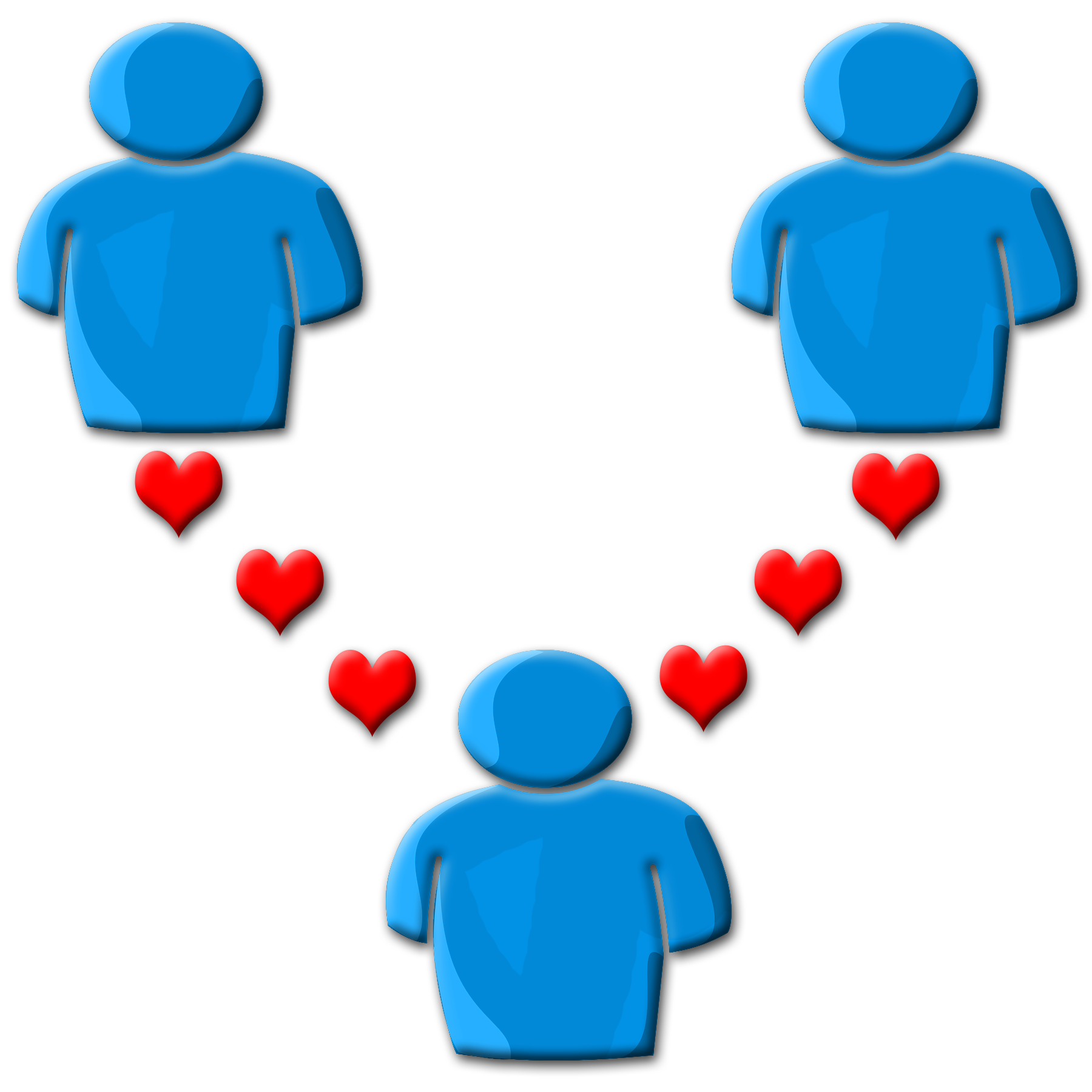 A vee is a group of 3 people where one person has a relationship with two other people, but those two people do not have a romantic relationship with each other, although they can be friends. You can have a vee with any arrangement of genders, depending upon the sexual orientation of those involved. Sometimes people will include letters that represent the sexes of the people involved, such as an FMF-vee, which means a vee relationship that includes two females and a male. Since the order of the letters is "FMF", it implies that the male is the person in the "middle", the "pivot", and the person who is dating the two females while the two females are probably not romantically involved with each other. The practice of including gender letters tends to be used more often by heterosexual cisgender people; those who are more familiar and comfortable with the diversity of genders and orientations tend to refrain from mentioning anyone's gender unless it's absolutely relevant and who tend to believe that it is not relevant in most circumstances.
A vee is a group of 3 people where one person has a relationship with two other people, but those two people do not have a romantic relationship with each other, although they can be friends. You can have a vee with any arrangement of genders, depending upon the sexual orientation of those involved. Sometimes people will include letters that represent the sexes of the people involved, such as an FMF-vee, which means a vee relationship that includes two females and a male. Since the order of the letters is "FMF", it implies that the male is the person in the "middle", the "pivot", and the person who is dating the two females while the two females are probably not romantically involved with each other. The practice of including gender letters tends to be used more often by heterosexual cisgender people; those who are more familiar and comfortable with the diversity of genders and orientations tend to refrain from mentioning anyone's gender unless it's absolutely relevant and who tend to believe that it is not relevant in most circumstances.
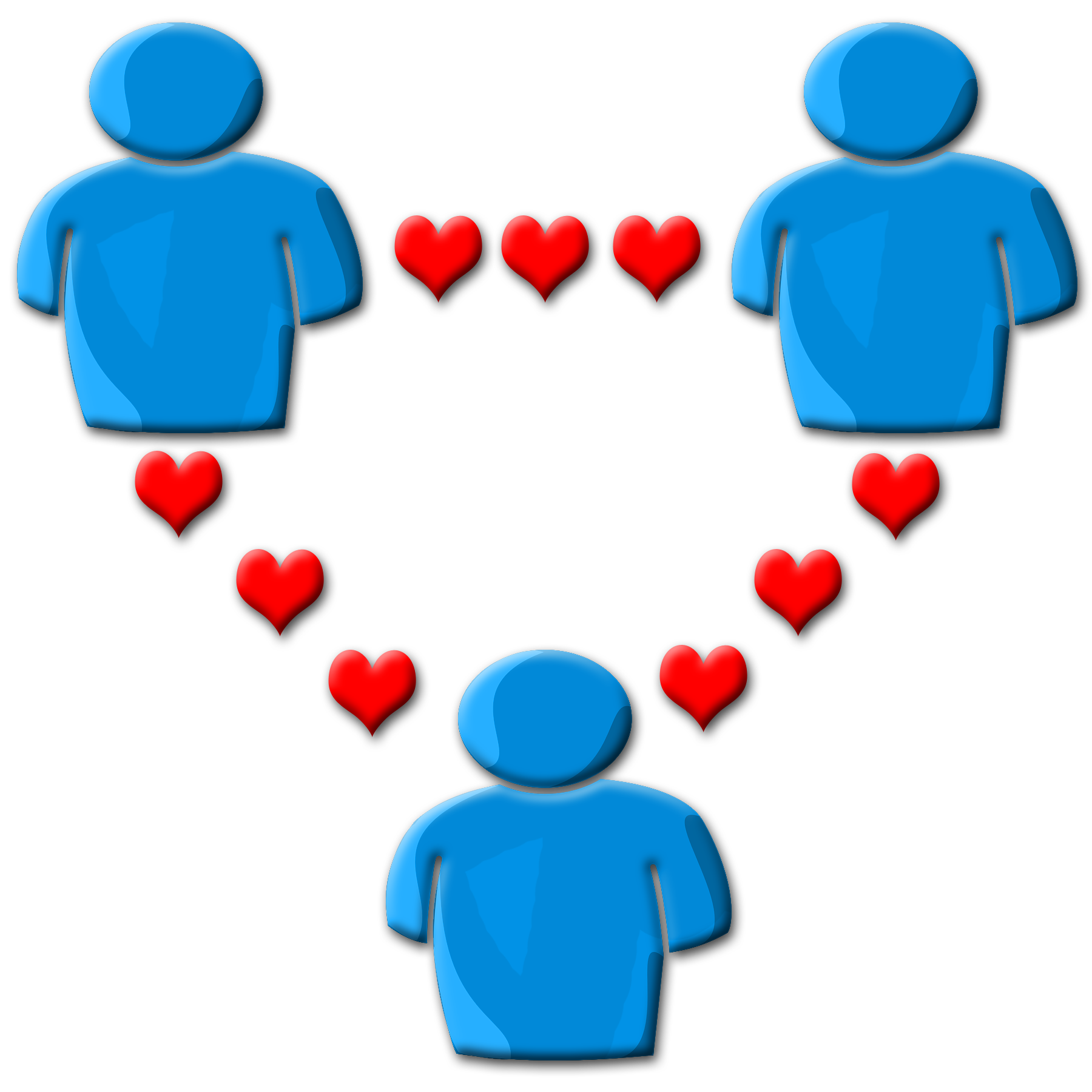 A triad is a group of 3 people that consider themselves all equally involved with each other. Sometimes two members of the triad are not sexually involved with each other, such as a FMF-vee where the two women are not having sex together, but they still consider themselves a "family" or one group, so if they call themselves a "triad", then it doesn't matter who is having sex with whom. The important part is that the three members consider themselves a family with each person being an equally contributing member to the family, so it's best not to make assumptions about who might be having sex with whom. Again, you can have any arrangement of genders, depending upon the sexual orientation of those involved.
A triad is a group of 3 people that consider themselves all equally involved with each other. Sometimes two members of the triad are not sexually involved with each other, such as a FMF-vee where the two women are not having sex together, but they still consider themselves a "family" or one group, so if they call themselves a "triad", then it doesn't matter who is having sex with whom. The important part is that the three members consider themselves a family with each person being an equally contributing member to the family, so it's best not to make assumptions about who might be having sex with whom. Again, you can have any arrangement of genders, depending upon the sexual orientation of those involved.
As I mentioned above, all group relationships are built upon the dyads that form them. So, with one dyad, which includes 2 people, you have one relationship - that of the two people. With one triad or vee that includes 3 people, you have four relationships! You have the relationship between each couple and also the triad as a whole. See each line of hearts in the triad graphic? That's 3 dyads. Now add the relationship of all 3 people together, which has its own special dynamic and its own needs separate from the relationships of each dyad involved.
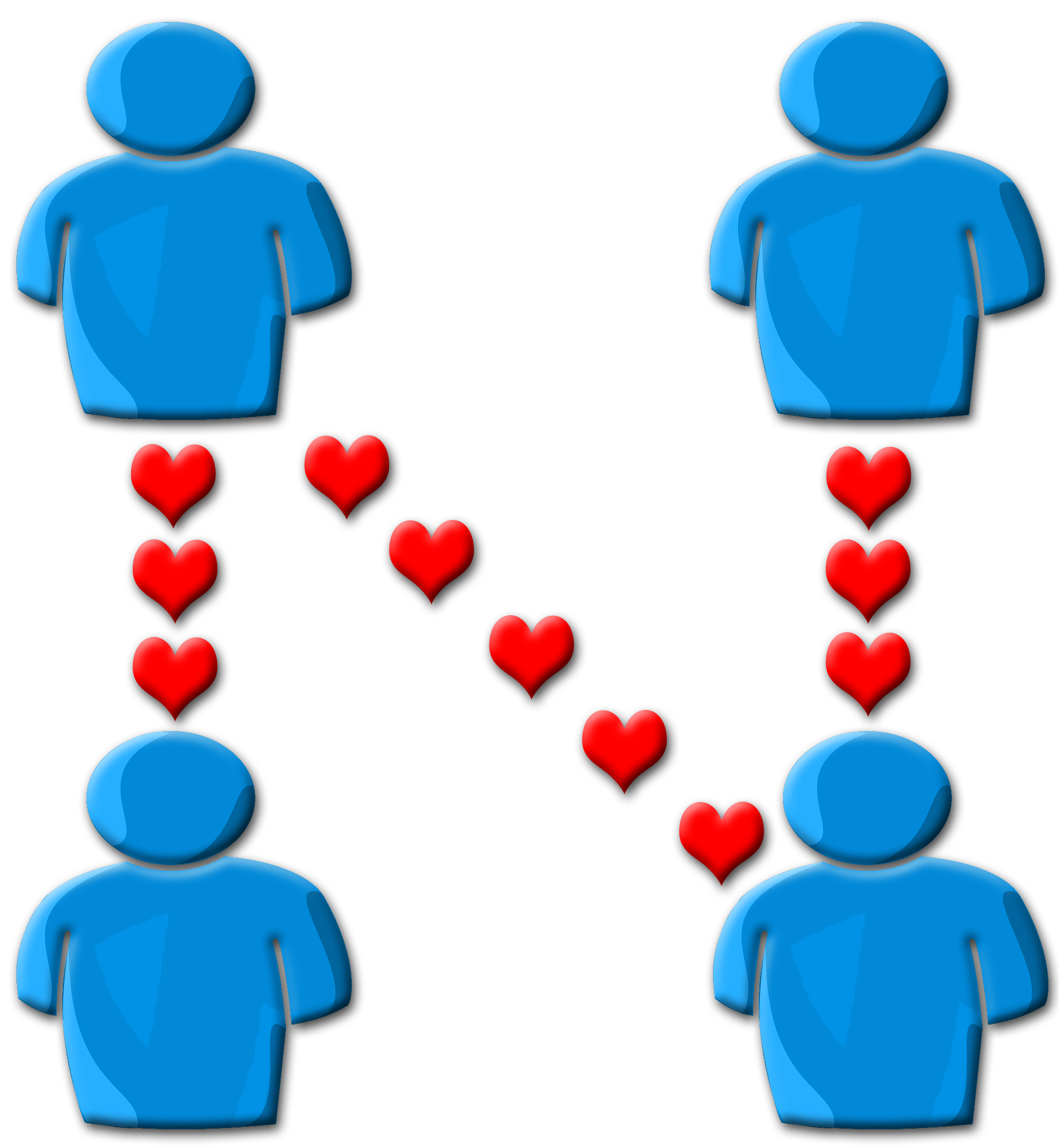 Next up we have "N" relationships. This is a poly relationship involving 4 people. It usually starts with two seperate couples and then one person from each couple gets involved with each other, thereby linking the two couples. Let's say that Bill is married to Suzy. John is dating Lucy. One day, Suzy meets John and they begin a romantic relationship. In the graphic, you can see why this configuration has its name. When you draw the lines connecting the romantic "dots", you get a picture that looks like the capital letter N. Sometimes this is illustrated as a letter "Z", or a square-shaped "U", but they're all the same idea.
Next up we have "N" relationships. This is a poly relationship involving 4 people. It usually starts with two seperate couples and then one person from each couple gets involved with each other, thereby linking the two couples. Let's say that Bill is married to Suzy. John is dating Lucy. One day, Suzy meets John and they begin a romantic relationship. In the graphic, you can see why this configuration has its name. When you draw the lines connecting the romantic "dots", you get a picture that looks like the capital letter N. Sometimes this is illustrated as a letter "Z", or a square-shaped "U", but they're all the same idea.
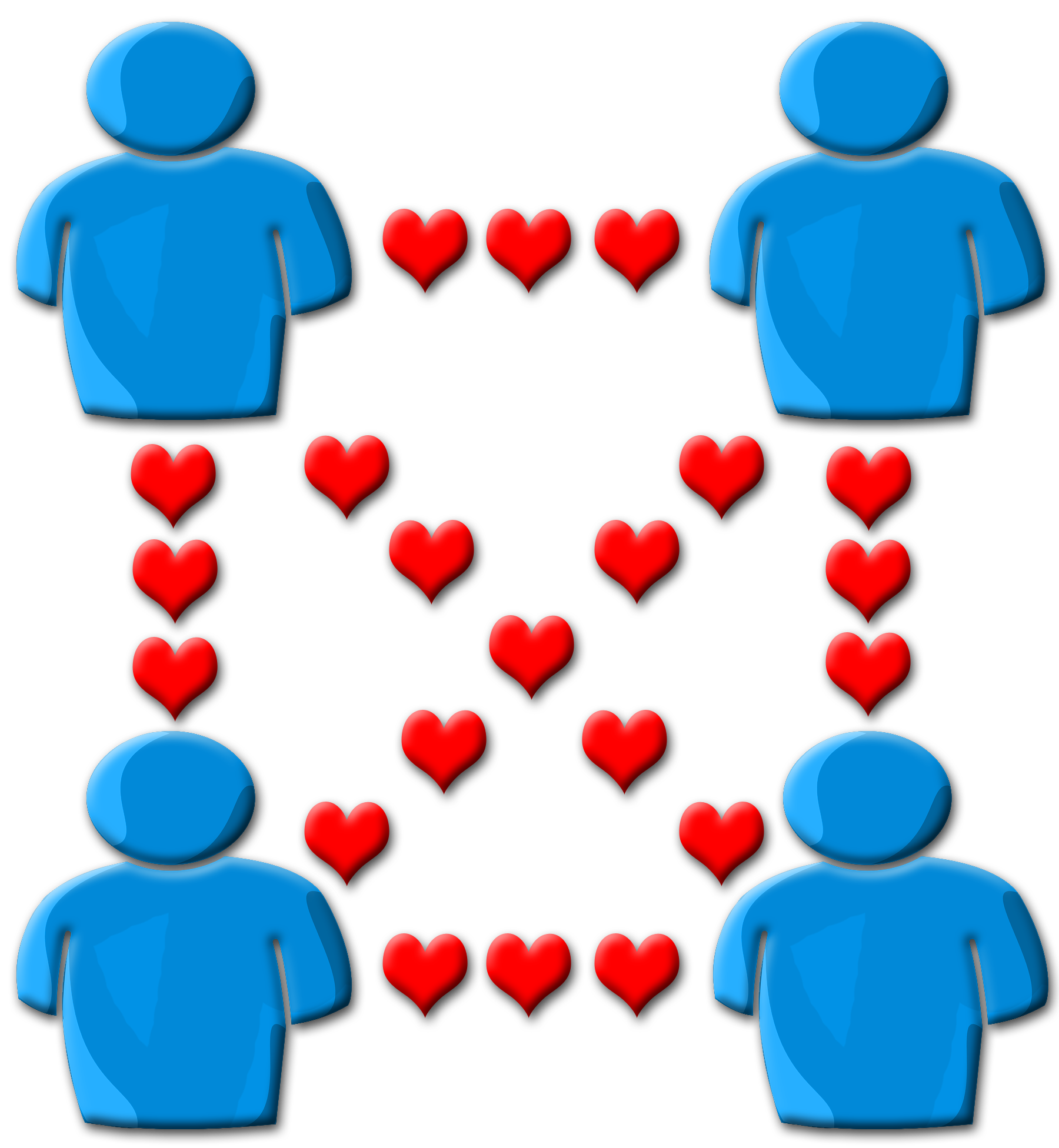 Another type of 4-person relationship is called a quad. Like a triad, this assumes "equal" status for all 4 people to each other. Again, there are groups that consider themselves a family even if every individual is not having sex with every other individual. So, regardless of genders or sexual orientation, each member of a quad considers themself to be romantically involved, or a "family", with each other member.
Another type of 4-person relationship is called a quad. Like a triad, this assumes "equal" status for all 4 people to each other. Again, there are groups that consider themselves a family even if every individual is not having sex with every other individual. So, regardless of genders or sexual orientation, each member of a quad considers themself to be romantically involved, or a "family", with each other member.
So now, in a relationship with 4 people, one might assume we have 7 relationships to maintain, right? One relationship for each dyad and one more for the whole group. Nope! In a group with 4 people, you have those 6 dyads. Each one of these couplings has its own unique characteristics and dynamics. But wait ... there's more! Not only do you have 6 different dyadic relationships, you also have 4 separate 3-person relationships!
If we assume the above example is a quad instead of an N, you have the following: Bill-Suzy-John; Bill-Suzy-Lucy; Bill-Lucy-John; Lucy-John-Suzy. Each of these triplings have their own characteristics, dynamics, and interactions. Then, you have the quad itself. When you add it all up, a group of 4 people includes 11 different relationships ... all of which need time and energy to maintain and all of which have different requirements from each other.
Groups above 4 people are rare and so do not have such widely-recognized terminology, but any geometric term that includes the total number of people is generally understood, such as "quint" or "sextet". Also, when you get above 3 or 4 people, unless the group is "polyfi", the geometric organization of the group tends to be somewhat fluid. There are several terms for any group over 3 or 4 people, particularly if the configuration is considered "open" (each individual is allowed to add partners who may or may not join the larger group), including "intimate network", "network", "tribe", "polycule", etc. This is the relationship model I prefer and I call my group a "network".
A network is sort of a catchall term to refer to many people who are all connected through romantic relationships, but everyone is not romantically connected to everyone else. Networks range from groups that look like straight lines to groups that look like spiderwebs and complex molecules and everything in between.

To give you an example of what a network can look like, here is a graphical representation of the Amorphous Squiggle, my romantic network:
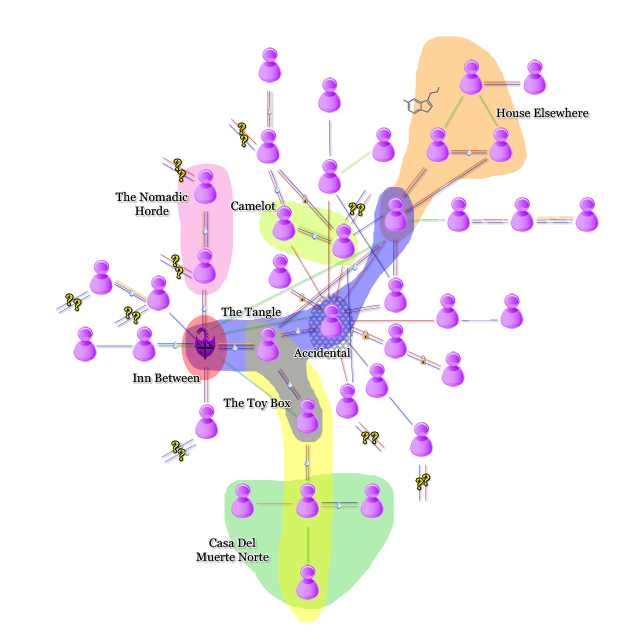
*A note about this image: This is an incomplete chart of the romantic connections in my network. This chart is an illustration about our network on one day in time. Our network is "open", meaning any individual is able to take any other partners (or lose any partners) as they see fit, with regards to their individual agreements with each of their partners. This means that the configuration changes all the time. Tomorrow, there may be more people to add, or there may be some people to remove from the image. I will not be keeping this image updated with each change. It is used to illustrate the concept of a network, and not intended to be an accurate portrayal of my network at the current time. My place on the chart is indicated by my Dragonshield.
Now, back to the original point, information about poly configurations. As I was saying above, each individual impacts every other individual within the group to some degree. As we saw with our group of 4 people, there are 11 total relationships to keep up with. What happens in larger groups, such as my network? The number of relationships multiplies geometrically. In a group of 6 people, you have a total of 57 relationships! In a group of, say, 15 people you get ... 32,752 unique relationships! Whew! That's a lot of relationships! That seems a bit extreme. How did I come up with that number? By using the Poly Formula™:
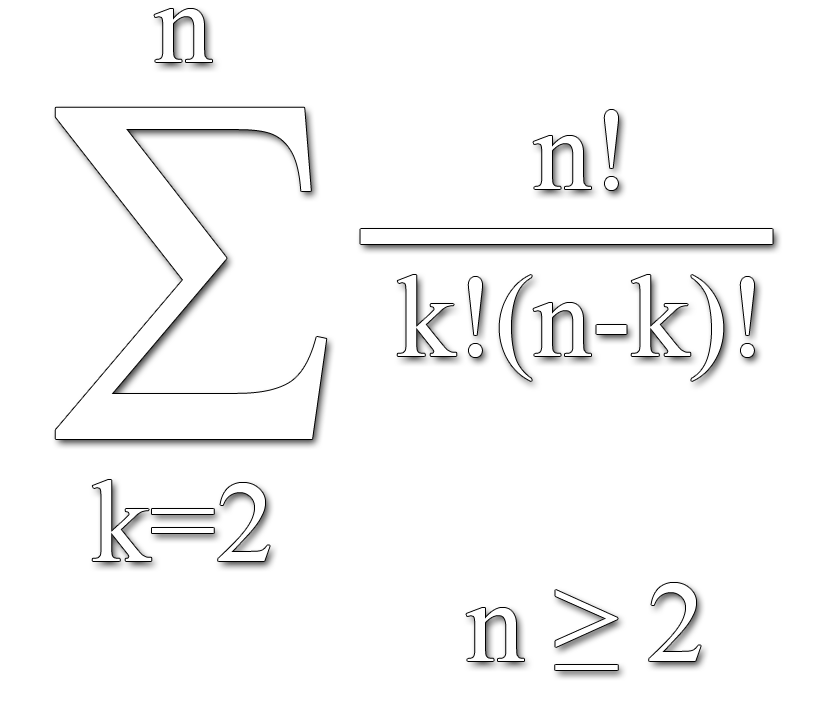
This was created at a party that I attended, which included an abnormally large concentration of poly math geeks who tried to count the number of people in the Squiggle at that moment. This formula is intended to give you the total number of all possible relationships for a group of any given size. Yes, there is a simpler formula of 2^n - n - 1 but I like the above formula better because it illustrates the complexity of multi-person relationships. Also, it looks great on a T-Shirt. Yes, t-shirt ... we're geeks.
When a person is part of a multi-person romantic relationship structure, it is beneficial to remember just how many people are affected by that person. Even if you don't remember the actual number, remembering the idea of this formula and the intricacy of the network chart is helpful in keeping things in perspective. In any relationship, the strength of the overall group is highly dependent upon the strength of each individual pair, even (and especially!) the non-romantic pairs - what Dr. Sheff calls the "Polyaffective Relationships". Each of these individuals affects everyone else, and can radically change the dynamics of all other relationships within the overall group including the overall group itself. Because of this, I often find when an individual does not consider how a new partner affects the existing partners, the entire group structure can implode rather spectacularly.
Imagine you want to throw a party. You have a rather ecclectic group of friends. Most of them have met before and usually get along rather well, socially. The party is off to a great start. People are talking and laughing and drinking and socializing, the food tastes great, the music has people dancing, everyone is having a good time. The door opens. It's your buddy John. John brought his new girlfriend, Julia. She's never met anyone here before, this is her first introduction into the group. She takes a drink to relax. She takes another one. As the night goes on, she is single-handedly ensuring there will be no alcohol left-overs.
As Julia relaxes, she starts to have difficulty filtering her speech. She has some pretty contrary ideas that not many other people at the party share. One minute you're in the living room, flirting with Dave's girlfriend Lucy, the next you're in the kitchen trying to rescue your good brandy glasses as Julia and Stephanie get into a "disagreement" that involves shattering crockery. You manage to seperate them and while you're calming Stephanie down, Julia and Peter start shouting at each other on the back deck, while your neighbors' bedroom lights are starting to turn on. One by one, Julia manages to anger your guests, although there are a few people who happen to agree with her point of view. Suddenly, you're perfect party is divided with people taking sides and no one is having a good time.
So, the solution is to ask John to take Julia home, right? Well, first John protests, getting angry that you don't like his new girlfriend. Then Julia gets offended and during the wrestling match that ensues, several of your other guests leave first. Another option is to keep Julia from drinking at the next party. Well, it turns out that Julia likes to drink and takes offense at anyone who tries to prevent her from drinking. Plus, she's pissed off a couple of people to the point that they refuse to attend any parties where she might be there, sober or otherwise.
So, you ask John not to bring her anymore because, frankly, you like your old friends better than Julia. Well, John was one of those people who agreed with her and is now mad at you for blacklisting his girlfriend. He posts on social media and tells all your mutual friends how you are biased against Julia and skews the facts to make you out to be a monster. Now the division from the party is not limited just to that one night. Your friends are all taking sides and lies and fabrications (not all intentional) are destroying the very fabric of your social circle.
Sound a little far fetched? Actually, this sort of thing happened at a party I attended once. Someone's new girlfriend was a little too belligerant and offensive and by the end of the night, the guests had seperated into two distinct cliques. Her behaviour continued past the party and affected quite a few people in the group. Now, imagine what can happen in a romantic circle, where those involved have much deeper emotional connections to each other. It can actually take very little to seriously hurt and offend one or more people when you have emotions and individual insecurities tied up in the dynamics of the group. If no resolution is found to the satisfaction of all involved, the hurt feelings can grow and feed upon good feelings and security, causing an ever-tightening spiral of pain and anger.
And when one person is hurting, their reactions and behaviour will affect other people in the group and eventually you will have the romantic equivalent of the party scene, with partners taking sides, and threats and insults hurled, and some people proclaiming that they refuse to be in the same room with that person ever again. Those caught in the middle will sometimes try and simply keep the offending parties seperated, but my sweetie Franklin has an awesome blog entry about the perils of that method. I prefer not to have to seperate my partners like naughty children. But more on that in the How I "Do" Poly section.
There is no One True Way to organize your poly relationships. The most successful relationships are not successful because they found the right configuration, but because the configuration they ended up with works the best for those particular people involved. Many newcomers to polyamory come up with some idea in their head that they think they would be happiest if their relationship looked a particular way, such as "I think a quad is the most balanced configuration" and "I think a polyfi triad would make me feel the most secure". This is always a mistake.
If you set out to find a person who will fit magically into this slot you have created in your life, you will have much difficulty finding that magic person. But if you allow your relationships to find their own natural path and listen to the needs of everyone and of the relationship itself, you may find yourself in a particular configuration that seems to work for you. Here are some more essays and articles on the idea of prescripting, or designing ahead of time, your future relationships, and on the inherent Couples Privilege that is wrapped up in hierarchy and prescriptive relationships:
- Because Sex Is A Lot Like Astrophysics
- Polyamory And Hierarchy
- Polyamory: So What Is Couples Privilege Anyway?
- Care And Feeding Of Secondary Relationships
- Some Thoughts On Game Changers
- Let's Open Our Relationship
- Before We Open Up, Let's Discuss Some Boundaries
- Can Polyamorous Hierarchies Be Ethical (pt. 2)
- Group Cohesion As A Coercive Tactic In Poly Relationships
The Inn Between © 2002
Contact The InnKeeper